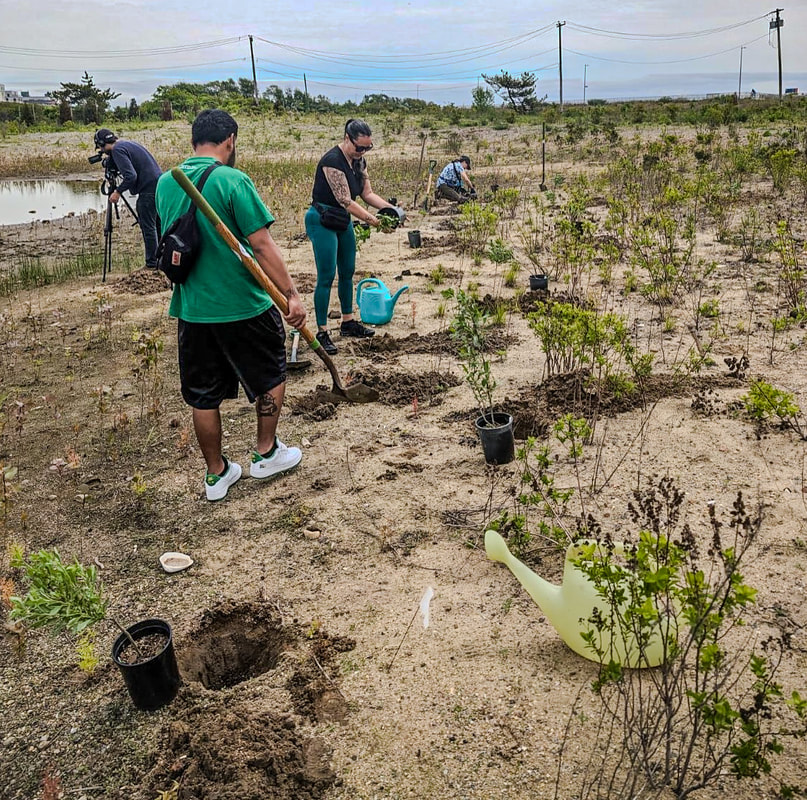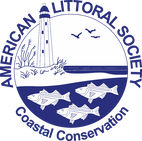|
The end of the school year and start of summer is a great time to look back on a season of the Littoral Society's Close Encounters field trips for students, scouts and recreation groups.
The Littoral Society's interactive field trips on Sandy Hook use nature as a classroom, and are not only exciting for students, but also members of our staff and volunteers. Everyone gets the chance to experience the breathtaking coastal environment, with each outing being different from the rest! Our Close Encounters field trip is designed to give students of all ages the opportunity to engage with nature in an enriching and educational manner. By learning about local species through hands-on interactions, students are able to appreciate the amazing ecosystems that surround them and create memories they’ll remember forever.
0 Comments
Do you care about horseshoe crabs? Then please join our continuing effort to help protect them!
The Atlantic States Marine Fisheries Commission (ASMFC) is holding a workshop on July 15 and 16 to discuss the management of Delaware Bay horseshoe crabs. The workshop will be held at the Delaware Department of Natural Resources & Environmental Control's Lewes Field Office at 901 Pilottown Road, Lewes, DE. Over the past few years, the ASMFC has attempted to increase the harvest limits for Delaware Bay horseshoe crabs and end a moratorium on harvesting female crabs, even though conservation targets previously agreed to by the Commission have not been reached. Public input in the past, including 34,000 letters in 2022, has helped stave off those proposed changes. According to ASMFC, the upcoming meeting is focused on "providing the space for participants to openly discuss ecosystem and management objectives, identify common ground among divergent stakeholder views, and develop options for Board discussion and consideration. ...no management decisions are being formulated or acted upon at the workshop." However, there will be only limited opportunity for public comments at the meeting and only from those attending in person. If you plan to attend the workshop, you must inform Senior Fishery Management Plan Coordinator Caitlin Starks by noon on Friday, July 12.  American Littoral Society Education Coordinator Audrey Litto leads a Horseshoe Crab Walk on Sandy Hook. American Littoral Society Education Coordinator Audrey Litto leads a Horseshoe Crab Walk on Sandy Hook. If you've ever visited one of Sandy Hook's bayside beaches during May or June, you've probably come across one of our favorite seasonal visitors, the slow moving and strange looking horseshoe crab. While not nearly as plentiful as they were only a few decades ago, these living fossils still appear in enough numbers to attract attention and occasionally concern from human visitors to our little corner of the Jersey Shore. Many people are familiar with horseshoe crabs, but some may not know just how remarkable they are and more than a few may never have seen one on a beach before. Which is why the American Littoral Society hosts horseshoe crab walks that coincide with the short period of time that the crabs emerge from New Jersey's bays and estuaries. These walks provide a great opportunity to not only see these ancient creatures as they crawl onto beaches, but also learn why they come ashore, how that is critical to the coastal ecosystem, and what makes them more than just a curious sight (such as their blue blood or multiple sets of eyes).  The Delaware 302 Horseshoe Crab lifestyle brand. The Delaware 302 Horseshoe Crab lifestyle brand. By Trevor Metz, Littoral Society Delaware Seasonal Technician During my last week with the American Littoral Society, I was treated to a guided tour around South Jersey by fellow staffers Toni Rose Tablante and Shane Godshall. It was one of the few times we got to interact in person during the short, three-month stint I worked with the Society, but we had the same kinds of candid conversations that we had during the interview process back in March. Driving between beaches where Littoral Society restoration projects have been completed or future projects are planned, our conversation turned towards how the work we are doing - or want to be doing - can be most impactful and effective. In Delaware, the Atlantic Horseshoe Crab (Limulus polyphemus) was chosen as the state’s official marine animal in 2002. A local lifestyle brand, 302 Horseshoe Crab, has gained considerable popularity in recent years prominently featuring our marine animal and single Delaware area code. Some special people will be recognized as coastal champions at the Littoral Society's Members Day event on Saturday, June 22.
Among the honorees are Lisa Fanning, our Seastreak Volunteer Coordinator; Kristin Villani, a Science Teacher at Mercy Center's Sisters Academy of New Jersey in Asbury Park, NJ; Dawn Payne, a 4th and 5th Grade Science teacher at Compass Academy Charter School in Vineland, NJ, and Adam Riback, a New York State Beach Cleanup beach captain and Executive Director of New York State Marine Education Association (NYSMEA). Community Partner Award - Lisa Fanning Lisa’s love for the natural world began on the beach at Coney Island, in her native Brooklyn, where her mom would say: “Let’s see what the tide brought in” and encouraged a young Lisa to be curious about the wildlife around her. By Trevor Metz, Littoral Society Delaware Seasonal Technician While the month of June typically sees a decrease in horseshoe crab spawning activity, our work in Delaware hasn’t slowed down at all! I have been from Wilmington to Lewes with a horseshoe crab in tow, helping talking with people and advocating on behalf our state’s official marine animal.
So far this season, despite a mix of beautiful and inclement weather, we have tagged 200 crabs in support of the Fish and Wildlife Service’s Cooperative Tagging Program. The rain held off during our most recent effort and we were lucky enough to have a beautiful rainbow cap off our evening. With a full moon later this week, we will host one more tagging event at Slaughter Beach on Wednesday, June 19. Spawning activity lasts from May through June, and sometimes into July. If you haven’t already, check for a convenient high tide at a local bay beach and witness this ancient migration firsthand! The Littoral Society would like to welcome our new Fish Tagging Program intern, Jack Glassberg. Please say “Hello” when you see him at Sandy Hook!
Jack has an impressive history tagging with Gray FishTag, which conducts research efforts on all species of fish and are in the forefront of satellite tagging studies worldwide. He is also an avid fisherman. "I am very excited to have such a passionate fisherman and scientist aboard," McGuckin says. A resident of Little Silver, NJ, Jack majors in environmental studies at Lehigh University. In his free time, he tags striped bass, bluefin tuna, and yellowfin tuna. Every year, the Littoral Society's Members Day is a chance to celebrate and show appreciation for our amazing community of supporters. This year, we're thrilled to unveil something new: a beach scene magnet featuring Red Knots and a horseshoe crab, painted by talented wildlife artist Carrie Smith!
The magnets, which will be available for purchase at Members Day for $5, are a scaled-down version of an acrylic painting done by Carrie. The original art will be included in our upcoming Littorally Local Sunset Cruise online auction (which will open for bidding on Thursday, September 19). Carrie's stunning Red Knot and Horseshoe Crab painting perfectly captures the essence of the Hidden Coast along the Jersey Shore. These majestic birds, known for their incredible migratory journeys, often find rest and food along our coastline. The horseshoe crab, a fascinating creature with a long and storied history, is another vital part of the coastal ecosystem. Protecting and sustaining them both has long been a part of the American Littoral Society's mission.  In conjunction with Cellular Tracking Technologies (CTT) and the Cape May Part Science Center, the American Littoral Society installed on May 8 a radio tracking station and a series of nodes along the shore of Reeds in Middle Township, NJ. This station will aid in the Littoral Society’s goal of tracking the movements of horseshoe crabs as they come back to spawn year after year. These new PowerTags are in addition to the tags the Society has been using for years that provide some basic insight on crab movement when tagged crabs are recaptured. The Delaware Bay is home to the largest population of spawning Atlantic horseshoe crabs, (Limulus polyphemus). The horseshoe crabs come ashore to spawn and lay eggs during the months of May and June, with peak spawning occurring during new and full moon events at high tide. Horseshoe crabs are keystone species, playing a very important ecological role. Migratory shorebirds, like the threatened Red Knot, (Calidris canutus), use the Delaware Bay as a stopover during their migrations from the tip of South America to the Canadian Arctic. They rely heavily on the easily digested fats and nutrients found in horseshoe crab eggs to regain weight and fuel their continuing migration. May was a busy month for the Littoral Society's New York office. In addition to working on local community outreach, education and improving habitats across three Boroughs (the Bronx, Coney Island and Jamaica Bay/Rockaway), staff also completed a highly successful Spring excursion to the DelMarVa coast.
Led by the Littoral Society's Jamaica Bay Guardian Don Riepe and Northeast Chapter Director Alexandra Kanonik, the Chincoteague was a hit. About 20 people gathered with us on the islands off the Delmarva Peninsula to enjoy the sights, food, ponies and their foals. We also had an up-close sighting of the Blue Grosbeak, early horseshoe crabs, and many other great bird and wildlife observations on our 4-day weekend from May 2-5. On Tuesday, May 7, Alex explored the shorelines of Pelham Bay Park in the Bronx at Orchard Beach with 50 students from local NYC DoE schools to learn about the habitats and geology of this special span of the Long Island Sound in partnership with the National Wildlife Federation. |
Archives
July 2024
Categories
All
|









